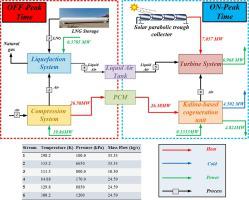当前位置:
X-MOL 学术
›
Energy Convers. Manag.
›
论文详情
Our official English website, www.x-mol.net, welcomes your
feedback! (Note: you will need to create a separate account there.)
Introducing a novel liquid air cryogenic energy storage system using phase change material, solar parabolic trough collectors, and Kalina power cycle (process integration, pinch, and exergy analyses)
Energy Conversion and Management ( IF 9.9 ) Pub Date : 2021-01-01 , DOI: 10.1016/j.enconman.2020.113653 Armin Ebrahimi , Bahram Ghorbani , Fatemeh Skandarzadeh , Masoud Ziabasharhagh
Energy Conversion and Management ( IF 9.9 ) Pub Date : 2021-01-01 , DOI: 10.1016/j.enconman.2020.113653 Armin Ebrahimi , Bahram Ghorbani , Fatemeh Skandarzadeh , Masoud Ziabasharhagh

|
Abstract Today, using new energy storage systems for peak shaving and load leveling with the approach of maximizing the efficiency of energy systems is inevitable. In the present study, a cogeneration integrated structure of power and cooling using liquefied natural gas regasification and solar collectors is developed and analyzed. In this regard, the purposes can be achieved by producing liquid air at an off-peak time and storing it as a cryogenic energy storage system and recovering it on-peak time. This new integrated structure generates 11.66 MW power and 4.502 MW cooling at the on-peak time. A Kalina-based combined cooling and power cycle and a gas turbine power generation unit are used to generate power from liquid air. Phase change material is used to store the heat from the compressed air entering the liquefaction stage (at the off-peak time) and recovering it at the on-peak time as the heat source of the Kalina cycle. Also, the solar parabolic trough collector provided with Zahedan climatic conditions the heat required for the direct expansion section. The electrical storage, round-trip, energy storage, and exergy efficiencies of the proposed energy storage system are 57.62%, 45.44%, 79.87%, and 40.17%, respectively. The most exergy destruction belongs to the heat exchangers section, which accounts for 50.85% of the total exergy destruction. One of the important results of the parametric study is the increase of round-trip and electrical storage efficiencies up to 47.59% and 61.60%, respectively, by minimizing the pressure of the inlet air to the liquefaction stage while maximizing the pressure of the liquid air inlet to the power generation stage.
中文翻译:

引入使用相变材料、太阳能抛物线槽收集器和 Kalina 动力循环(过程集成、夹点和火用分析)的新型液态空气低温储能系统
摘要 如今,通过最大限度提高能源系统效率的方法,使用新的储能系统进行调峰和负载均衡是不可避免的。在本研究中,开发和分析了利用液化天然气再气化和太阳能集热器的电力和冷却的热电联产一体化结构。在这方面,可以通过在非高峰时间生产液态空气并将其存储为低温储能系统并在高峰时间将其回收来实现该目的。这种新的集成结构在高峰时段可产生 11.66 MW 的电力和 4.502 MW 的冷却能力。基于 Kalina 的联合冷却和动力循环和燃气轮机发电机组用于从液态空气中发电。相变材料用于储存进入液化阶段(在非高峰时间)的压缩空气的热量,并在高峰时间将其回收,作为卡利纳循环的热源。此外,太阳能抛物线槽式集热器提供了 Zahedan 气候条件直接膨胀部分所需的热量。所提出的储能系统的电力存储、往返、储能和火用效率分别为 57.62%、45.44%、79.87% 和 40.17%。火用破坏最多的是换热器部分,占总火用破坏的 50.85%。参数研究的重要结果之一是往返效率和电存储效率分别提高了 47.59% 和 61.60%,
更新日期:2021-01-01
中文翻译:

引入使用相变材料、太阳能抛物线槽收集器和 Kalina 动力循环(过程集成、夹点和火用分析)的新型液态空气低温储能系统
摘要 如今,通过最大限度提高能源系统效率的方法,使用新的储能系统进行调峰和负载均衡是不可避免的。在本研究中,开发和分析了利用液化天然气再气化和太阳能集热器的电力和冷却的热电联产一体化结构。在这方面,可以通过在非高峰时间生产液态空气并将其存储为低温储能系统并在高峰时间将其回收来实现该目的。这种新的集成结构在高峰时段可产生 11.66 MW 的电力和 4.502 MW 的冷却能力。基于 Kalina 的联合冷却和动力循环和燃气轮机发电机组用于从液态空气中发电。相变材料用于储存进入液化阶段(在非高峰时间)的压缩空气的热量,并在高峰时间将其回收,作为卡利纳循环的热源。此外,太阳能抛物线槽式集热器提供了 Zahedan 气候条件直接膨胀部分所需的热量。所提出的储能系统的电力存储、往返、储能和火用效率分别为 57.62%、45.44%、79.87% 和 40.17%。火用破坏最多的是换热器部分,占总火用破坏的 50.85%。参数研究的重要结果之一是往返效率和电存储效率分别提高了 47.59% 和 61.60%,











































 京公网安备 11010802027423号
京公网安备 11010802027423号